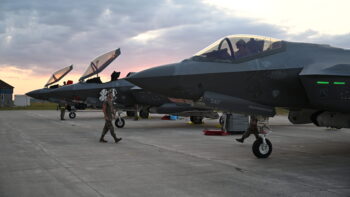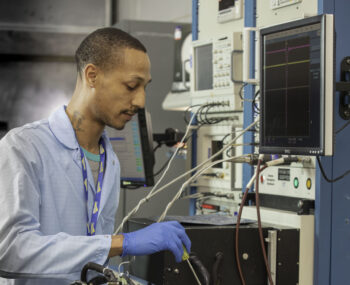
Navy Commander Kevin Blenkhorn works with his Joint Services teammates during the U.S. Army’s ‘Cyber Center of Excellence’, Fort Gordon in Augusta, Ga., hosted a multi-service ‘NetWar’ to show, and build, cyber Warrior capabilities Tuesday, June 10. (Georgia Army National Guard photo by Staff Sgt. Tracy J. Smith)
WASHINGTON — If the US doesn’t take immediate action to catch up to China in emerging tech fields, it risks a future of “weakness and dependence,” according to a blistering new report from the data analytics firm Govini.
“America is falling short in rapidly incorporating cutting-edge software and hardware into military platforms and munitions,” according to the company’s 2023 National Security Scorecard. “We are neither innovating our way past those historic capabilities, nor innovating our way to accelerated production of them. Instead, we are grappling with major shortfalls of munitions, are behind schedule on critical modernization programs including in the nuclear triad, and have no prospects of successfully achieving the shipbuilding targets that a potential Indo-Pacific conflict demands.”
Govini releases reports annually that evaluate the performance of the federal government. The 2022 version found that the US government nearly doubled its spending on critical technologies from $60.7 billion in fiscal 2017 to $117.2 billion in FY21. However, the US still wasn’t investing enough in the firm’s estimation to avoid losing the artificial intelligence (AI) and machine learning (ML) technological race.
In this year’s report, Govini evaluated the US’s progress on 12 top critical national security technologies through the lens of acquisition, procurement, supply chain, foreign influence and adversarial capital and science and technology. It found of the 12, a majority of the areas experienced increased investments, while spending in areas like space technology and advanced communications by the federal government declined.
But despite those investments, the US still might not be quick enough to outpace China, partly because of the “largely stagnating patents” in those areas, Govini CEO Tara Murphy told reporters during a briefing today.
“In many cases, United States patent grants are actually declining,” she said. “And then there’s a stark contrast to the trends that you see happening in China, where again in every single of these 12 [areas], the patent grants are on the rise.”
For example, in the area of artificial intelligence/machine learning and autonomy, Govini reports that patents have increased 18.3 percent from FY18 to FY22. According to the report, 200,000 patents were granted to the US in this area, but China far surpassed this with over 350,000 patents.
Murphy added that the US is also “highly dependent on Chinese entities for completing their projects, for developing their products, for bringing their goods and services to the market, and that market includes some of our most sensitive national security programs.”
Bob Work, former deputy secretary of defense and chairman of the board for Govini, told reporters patents are “a leading indicator of technological dominance in the future.”
“It’s the seed corn for making new discovers that put you on the top of the competitive food chain,” he said. “And that’s what scares me the most. China is doing far better than us in terms of the overall number of patents.”
Overall, DoD Is Increasing Investments In Critical Tech Areas
According to the report, the Army leads the military services and DoD agencies in overall spending on emerging tech, reaching $119.6 billion, a 31.9 percent increase from FY18 to FY22, with investments in biotechnology leading the way in FY22. The Navy and Air Force also increased their spending by 18.7 percent and 6.8 percent, respectively.
Other DoD agencies separate from the military services, like the Defense Advanced Research Project Agency, Defense Information Systems Agency, Defense Threat Reduction Agency and Missile Defense Agency, all reported an uptick in their own spending levels. US Special Operations Command was the only component with a decrease in spending, down 25.5 percent ($946.8 million).
Federal spending overall on advanced materials nearly doubled to $6.4 billion from FY18 to FY22, followed closely by biotechnology, which was up 35.4 percent for a total of $251.6 billion. Spending on all other areas in the report — renewable energy, hypersonics, nuclear modernization, super computing, microelectronics, advanced manufacturing, AI/ML and directed energy — also went up.
The two areas with negative growth, the report said, were space technology, down 1.3 percent for a total of $89 billion, and advanced communications, down 3.7 percent with a total of $35.7 billion.
Preliminary discussions lead Boeing to offer CH-47F Chinook to Poland
It remains to be seen how many aircraft Warsaw will commit to, should it go ahead with an order of the US Army aircraft or if a wider industry competition is to begin near term.





















![Multifunction Infographic_22-071[1]](https://breakingdefense.com/wp-content/uploads/sites/3/2023/09/Multifunction-Infographic_22-0711-350x263.png)




